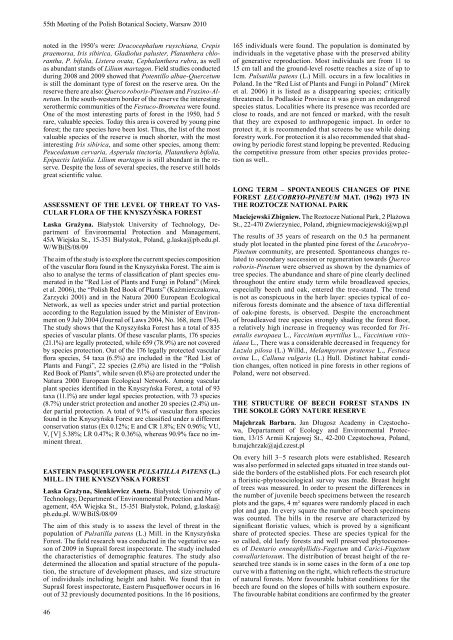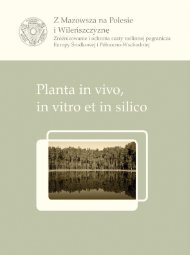acta societatis botanicorum poloniae - LV Zjazd Polskiego ...
acta societatis botanicorum poloniae - LV Zjazd Polskiego ...
acta societatis botanicorum poloniae - LV Zjazd Polskiego ...
Create successful ePaper yourself
Turn your PDF publications into a flip-book with our unique Google optimized e-Paper software.
55th Meeting of the Polish Botanical Society, Warsaw 2010<br />
noted in the 1950’s were: Dracocephalum ruyschiana, Crepis<br />
praemorsa, Iris sibirica, Gladiolus paluster, Platanthera chlorantha,<br />
P. bifolia, Listera ovata, Cephalanthera rubra, as well<br />
as abundant stands of Lilium martagon. Field studies conducted<br />
during 2008 and 2009 showed that Potentillo albae-Quercetum<br />
is still the dominant type of forest on the reserve area. On the<br />
reserve there are also: Querco roboris-Pinetum and Fraxino-Alnetum.<br />
In the south-western border of the reserve the interesting<br />
xerothermic communities of the Festuco-Brometea were found.<br />
One of the most interesting parts of forest in the 1950, had 5<br />
rare, valuable species. Today this area is covered by young pine<br />
forest; the rare species have been lost. Thus, the list of the most<br />
valuable species of the reserve is much shorter, with the most<br />
interesting Iris sibirica, and some other species, among them:<br />
Peucedanum cervaria, Asperula tinctoria, Platanthera bifolia,<br />
Epipactis latifolia. Lilium martagon is still abundant in the reserve.<br />
Despite the loss of several species, the reserve still holds<br />
great scientific value.<br />
ASSESSMENT OF THE LEVEL OF THrEAT TO VAS-<br />
CULAR fLoRA of tHE KNySZyńSKA foRESt<br />
Łaska Grażyna. Białystok University of Technology, Department<br />
of Environmental Protection and Management,<br />
45A Wiejska St., 15-351 Białystok, Poland, g.laska@pb.edu.pl.<br />
W/WBiIŚ/08/09<br />
The aim of the study is to explore the current species composition<br />
of the vascular flora found in the Knyszyńska Forest. The aim is<br />
also to analyse the terms of classification of plant species enumerated<br />
in the “Red List of Plants and Fungi in Poland” (Mirek<br />
et al. 2006), the “Polish Red Book of Plants” (Kaźmierczakowa,<br />
Zarzycki 2001) and in the Natura 2000 European Ecological<br />
Network, as well as species under strict and partial protection<br />
according to the Regulation issued by the Minister of Environment<br />
on 9 July 2004 (Journal of Laws 2004, No. 168, item 1764).<br />
The study shows that the Knyszyńska Forest has a total of 835<br />
species of vascular plants. Of these vascular plants, 176 species<br />
(21.1%) are legally protected, while 659 (78.9%) are not covered<br />
by species protection. Out of the 176 legally protected vascular<br />
flora species, 54 taxa (6.5%) are included in the “Red List of<br />
Plants and Fungi”, 22 species (2.6%) are listed in the “Polish<br />
Red Book of Plants”, while seven (0.8%) are protected under the<br />
Natura 2000 European Ecological Network. Among vascular<br />
plant species identified in the Knyszyńska Forest, a total of 93<br />
taxa (11.1%) are under legal species protection, with 73 species<br />
(8.7%) under strict protection and another 20 species (2.4%) under<br />
partial protection. A total of 9.1% of vascular flora species<br />
found in the Knyszyńska Forest are classified under a different<br />
conservation status (Ex 0.12%; E and CR 1.8%; EN 0.96%; VU,<br />
V, [V] 5.38%; LR 0.47%; R 0.36%), whereas 90.9% face no imminent<br />
threat.<br />
EASTErN PASqUEFLOWEr PulsAtillA PAtens (L.)<br />
MILL. IN tHE KNySZyńSKA foRESt<br />
Łaska Grażyna, Sienkiewicz Aneta. Białystok University of<br />
Technology, Department of Environmental Protection and Management,<br />
45A Wiejska St., 15-351 Białystok, Poland, g.laska@<br />
pb.edu.pl. W/WBiIŚ/08/09<br />
The aim of this study is to assess the level of threat in the<br />
population of Pulsatilla patens (L.) Mill. in the Knyszyńska<br />
Forest. The field research was conducted in the vegetative season<br />
of 2009 in Supraśl forest inspectorate. The study included<br />
the characteristics of demographic features. The study also<br />
determined the allocation and spatial structure of the population,<br />
the structure of development phases, and size structure<br />
of individuals including height and habit. We found that in<br />
Supraśl forest inspectorate, Eastern Pasqueflower occurs in 16<br />
out of 32 previously documented positions. In the 16 positions,<br />
46<br />
165 individuals were found. The population is dominated by<br />
individuals in the vegetative phase with the preserved ability<br />
of generative reproduction. Most individuals are from 11 to<br />
15 cm tall and the ground-level rosette reaches a size of up to<br />
1cm. Pulsatilla patens (L.) Mill. occurs in a few localities in<br />
Poland. In the “Red List of Plants and Fungi in Poland” (Mirek<br />
et al. 2006) it is listed as a disappearing species; critically<br />
threatened. In Podlaskie Province it was given an endangered<br />
species status. Localities where its presence was recorded are<br />
close to roads, and are not fenced or marked, with the result<br />
that they are exposed to anthropogenic impact. In order to<br />
protect it, it is recommended that screens be use while doing<br />
forestry work. For protection it is also recommended that shadowing<br />
by periodic forest stand lopping be prevented. Reducing<br />
the competitive pressure from other species provides protection<br />
as well..<br />
LONG TErM – SPONTANEOUS CHANGES OF PINE<br />
FOrEST leucobryo-Pinetum MAT. (1962) 1973 IN<br />
THE rOZTOCZE NATIONAL PArK<br />
Maciejewski Zbigniew. The Roztocze National Park, 2 Plażowa<br />
St., 22-470 Zwierzyniec, Poland, zbigniewmaciejewski@wp.pl<br />
The results of 35 years of research on the 0.5 ha permanent<br />
study plot located in the planted pine forest of the Leucobryo-<br />
Pinetum community, are presented. Spontaneous changes related<br />
to secondary succession or regeneration towards Querco<br />
roboris-Pinetum were observed as shown by the dynamics of<br />
tree species. The abundance and share of pine clearly declined<br />
throughout the entire study term while broadleaved species,<br />
especially beech and oak, entered the tree-stand. The trend<br />
is not as conspicuous in the herb layer: species typical of coniferous<br />
forests dominate and the absence of taxa differential<br />
of oak-pine forests, is observed. Despite the encroachment<br />
of broadleaved tree species strongly shading the forest floor,<br />
a relatively high increase in frequency was recorded for Trientalis<br />
europaea L., Vaccinium myrtillus L., Vaccinium vitisidaea<br />
L., There was a considerable decreased in frequency for<br />
Luzula pilosa (L.) Willd., Melampyrum pratense L., Festuca<br />
ovina L., Calluna vulgaris (L.) Hull. Distinct habitat condition<br />
changes, often noticed in pine forests in other regions of<br />
Poland, were not observed.<br />
THE STrUCTUrE OF BEECH FOrEST STANdS IN<br />
tHE SoKoLE GóRy NAtURE RESERvE<br />
Majchrzak Barbara. Jan Długosz Academy in Częstochowa,<br />
Departament of Ecology and Environmental Protection,<br />
13/15 Armii Krajowej St., 42-200 Częstochowa, Poland,<br />
b.majchrzak@ajd.czest.pl<br />
On every hill 3– 5 research plots were established. Research<br />
was also performed in selected gaps situated in tree stands outside<br />
the borders of the established plots. For each research plot<br />
a floristic-phytosociological survey was made. Breast height<br />
of trees was measured. In order to present the differences in<br />
the number of juvenile beech specimens between the research<br />
plots and the gaps, 4 m² squares were randomly placed in each<br />
plot and gap. In every square the number of beech specimens<br />
was counted. The hills in the reserve are characterized by<br />
significant floristic values, which is proved by a significant<br />
share of protected species. These are species typical for the<br />
so called, old leafy forests and well preserved phytocoenoses<br />
of Dentario enneaphyllidis-Fagetum and Carici-Fagetum<br />
convallarietosum. The distribution of breast height of the researched<br />
tree stands is in some cases in the form of a one top<br />
curve with a flattening on the right, which reflects the structure<br />
of natural forests. More favourable habitat conditions for the<br />
beech are found on the slopes of hills with southern exposure.<br />
The favourable habitat conditions are confirmed by the greater



